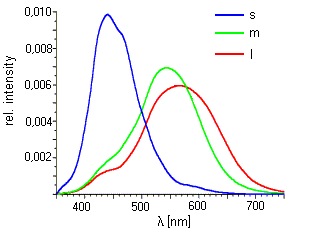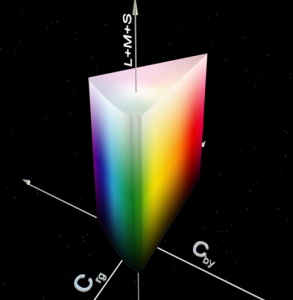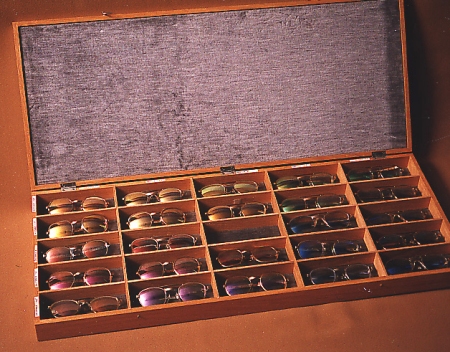 |
BMe Research Grant |

|

Department of Mechatronics, Optics and Engineering Informatics
H-1521 Budapest
Bertalan Lajos u. 4-6.
Building D, 407
Home page
Faculty of Mechanical Engineering
Department of Mechatronics, Optics and Engineering Informatics
Color Engineering Research Laboratory
Introducing the research area
The human sensory system perceives information of the surrounding world through its five main sensing organs. Among our sensors human eye is responsible for the perception of more than 90% of the incoming information. Our visual system is able to process color signals comprising one of the most important data for human perception.
The aim of color engineering research laboratory of the Department of Mechatronics, Optics and Engineering Informatics is to research and understand the processing of this color information from the engineering point of view. Three specific areas of this wide science are in focus at the laboratory:
-
diagnosis and correction of human color deficiency
-
research of color displays
-
research and development of light sources
Brief introduction of the research place
The Color Engineering Research Laboratory is part of the Department of Mechatronics, Optics and Engineering Informatics which is one of the three largest departments of the Faculty of Mechanical Engineering at the Budapest University of Technology and Economics. Besides the scientific fields comprising the name of the department, several interdisciplinary areas are being researched here.
The Department is responsible for the discipline of Mechatronic Engineering at both BSc and MSc levels having the highest entrance level for engineering courses in Hungary. The Department also manages its own PhD subprogram.
The colleagues at the Color Engineering Research Laboratory have MSc degrees in mechanical, electrical and informatics engineering and most of them have concluded the PhD. Our colleagues manage several national and international R&D projects annually in the related areas.
History and context of the research
The first steps in color engineering were the establishment of the research project on color vision deficiency correction by Dr. György Ábrahám and Dr. Klára Wenzel, professors of the Department of Precision Mechanics and Optics (predecessor for the Department). Initially, scientific work had been carried out involving students, in the frames of diploma and scientific competition work and soon the research resulted in new findings on the concept of color vision deficiency and its correction became the next target. (The so-called red-green color deficiency inherited genetically is a still uncurable problem, however, it can be corrected by means of specific color filters.)
To understand the optical and psychological principles and methods of color deficiency correction, some basic research has been carried out at the laboratory. Modern mathematical methods have been applied in the modeling of human color vision that resulted in the development of several new tools and instruments for color vision measurement and diagnosis. These were then tested on more than 600 color deficient university students. In 1993 the method of the first generation color correction filters were patented, followed by a patent on new color vision measurement instrument in 1995. The patent costs were covered by the Hungarian Patent Bureau [1, 2, 3, 4].
Recently adopted directions in color vision research target the more accurate understanding and diagnosis of the different color deficiency types. This includes research on computer color displays used in the qualitative and quantitative testing and diagnoses of color deficiency.
The research on computer displays has been involved in color vision research when searching for new test methods and especially when developing new test equipment. The design and construction of a new instrument always requires signiificant financial support. However, if the development work was confined to software using available computer displays the distribution and application of color vision testing could be made more affordable. Therefore the first step in researching monitor-based color vision applications was the implementation of standard color vision tests for the computer. Obviously, this required the analysis and measurement (calibration) of various types of color display technologies and products.
Research and development of light sources is based on the cooperation between the Department and GE Hungary Ltd., a leading manufacturer of lighting applications worldwide. Several joint projects target the development of light sources based on our knowledge of the human color vision. In parallel with this, the Department is conducting human visual tests on several new light source types.
Aim of the research
Inherited color deficiency is a genetical problem of human color vision. In Europe approximately 8% of the male and 0.5% of the female population is color deficient to some extent. Color deficiency also can be acquired as side effect of diseases, poisoning or alcoholism, however, this type of the problem is generally curable.
Inherited color deficiency on the other hand cannot be cured medically. Correction filters, however, are available for treatment and significant improvement.
One of the primary goals for our research laboratory is to provide convenient and applicable color vision correction glasses (and contact lenses) that can be successful in both scientifically and both on the market.
Besides the correction glasses we also have the task to develop and construct easily applicable tests and diagnostic systems for the use by medical professionals.
The scientific activities in researching and developing of novel light sources targeted the improvement of the compact and linear fluorescent lamps replacing the classical and outdated incandescent lighting solutions with special focus on the following parameters:
-
color rendering
-
perceived brightness
-
luminous efficiency
The analysis and evaluation of the newly developed light sources also require the development of novel methods and applications for human visual testing.
Methods
The photoreceptors of human vision are located at the back of the eye. Color vision is realized with the three different pigments of the cone photoreceptors (l - protos, m - deuteros, s - tritos). Their spectral sensitivity curves are displayed in the following figure:

Fig.1. – Spectral sensitivity of the human cone photoreceptors
The main cause of color deficiency is the shift of one of these sensitivity curves with wavelength. Based on this, several different types are known (Fig.2.).

Fig. 2. - Spectral sensitivity curves of protan and deutan color deficients
To compensate the sensitivity shift specially designed color filters are applied. The color filter layers are designed so that they modify the incoming light’s spectral distribution in a way that stimulates the color deficient eye like one of a color-normal. For this the spectral transmission characteristics of the color filters have to achieve the correct spectral positioning of the sensitivity curves such as in Fig.1. The reduction in light input caused by the application of filters is compensated by the adaptation ability of the human visual system [4, 5].
The large variety of color deficiency types require the specification and design of several correction filters. Therefore, we have designed and created a set of color deficiency correction glasses which can be conveniently and rapidly applied in the practice of color vision correction.
Our research group has also developed novel color vision test instruments such as the PDT 2000 and Anomalchecker, which are currently being further improved [6, 7].
Additionally to these non-instrumental test methods, several others are constantly being developed mainly using computer color displays such as the CRT and the LCD. For the adequate application of color vision tests the monitors have to be calibrated and here we can apply our newly developed monitor calibration system. Significantly more cost effective, although, less accurate visual calibration methods are also being developed using the human eye as a calibration tool.
Several of the classical color vision test methods have been implemented for the computer display. Besides the Farnsworth and Ishihara tests, new methods have also been worked out such as the MMAM (Modified Minimal Apparent Motion Test) and the CCSF (Color Contrast Sensitivity Function) [10, 11, 12].
Our new light sources development project is based on the methods of phosphor coating design and testing worked out at the laboratory. According to the latest directives of the European Union, classical incandescent light sources are continuously being replaced by fluorescent types which, unfortunately lack significantly in color rendering. The main aspect of their design; therefore, is the spectral power distribution of their emission creating the most adequate and ergonomic lighting for human vision. To create the spectral emission characteristic necessary for the specific purposes we have to modify and specifically design the phosphor coating of fluorescent lamps. Output parameters for the optimization are color rendering (gamut area), correlated color temperature and luminous efficiency. The optimization of the color gamut is supported by the Organic Color System (OCS) created by Dr. György Ábrahám [13].

Fig. 3. - The Organic Color System (OCS)
The research work is constantly producing new phosphor coating receipts that improve color rendering and/or color gamut area while maintaining correlated color temperature and luminous efficiency.
The light sources developed are tested with photometric measurement equipment along with different human visual tests. Our laboratory has developed new human test instruments and methods such as perceived brightness testing system and color contrast test that can evaluate human vision through objective parameters. The results of the human tests provide feedback for the phosphor coating design facilitating further light source development work [14].
Results
The projects on color deficiency diagnoses and correction have already provided several scientific results during the long research period:
-
color vision correction glasses – as product
-
color vision test instruments: Anomalchecker, PDT 20000
-
15 patents (including international patents)
-
3 spin-off companies applying the results of the research group: Colorlite Plc., Daltonon Ltd., Colorlite Ltd.
-
8 international exhibitions: Hannover, Strasbourg etc.
-
1 Doctor of Science degree of the Hungarian Academy of Sciences
-
2 habilitations
-
5 PhD degrees
Results in the field of computer displays research:
-
new calibration methods
-
color vision tests applied to computer monitors
Results of light sources research and development:
-
development of a novel test series for the human visual evaluation of light sources
-
development of novel light sources
Expected impact and further research
The color deficiency correction glasses are currently available on the international market through spin-off companies. The international ophthalmology community has welcomed the possibility of correcting color deficiency. In Hungary several hundreds of color deficient people could choose professions where good color vision was a requirement with the aid of these glasses.

Fig.4. - The set of color deficiency correction glasses
The manufacturing of the color vision correction glasses still faces multiple challenges. Further researches will be required to decide whether thermodiffusion or vacuum evaporation technology should be applied in the future.
From the side of the customers, there is a demand for color vision correction via contact lenses – a further challenge for the research group.
The diagnosis of color vision is a priority in our future developments. Accurate and inevitable diagnosis is necessary for the determination of the appropriate color correction glasses. The research laboratory is working on several new test methods and measurement instruments for this purpose.
The novel phosphor coatings modeled and calculated by the research group are in the process of realization and introduction to the market. Human visual tests are continuously supporting the model calculations. Considering the latest changes in lighting market and applications, we expect a large proportion of research and development to be launched on special light sources and spectral improvement in cooperation with GE Hungary Ltd.
Publications, references, links
5 significant publications from the last 5 years:
Ábrahám Gy, Katona P, Kovács R, Nagy B, Tóth Katalin
A megvilágítás hatása a színlátásra (Effect of Illumination on Color Vision - in Hungarian)
MŰSZAKI SZEMLE: 30-35 (2009)
Wenzel K, Samu K, Langer I.
Színtani gyakorlókönyv színtévesztőknek - alapfokú gyakorlókönyv (Colorimetric training book for people with color deficiency - in Hungarian)
ISBN 978-963-06-6698-5 (2009)
Wenzel K, Samu K, Mihalik G
Colorimetric training book,
CIE Light and Lighting Conference, CIE Proceedings PwDaS-46, Budapest (2009)
Gy Ábrahám, B V Nagy
Organic Color System
AIC Symposium, Budapest (2007)
Ábrahám Gy
Filter technology applying to the improvement of the human vision
8th Int. Conf. on Mechatronics and Precision Engineering, pp. 157–160, Cluj-Napoca, Romania (2006)
5 significant publications from the previous time period:
Abraham G, Korosi H, Schanda J, Shapiro A G, Wenzel K
Anomalies in additive color matches
COLOR RESEARCH AND APPLICATION 20:(4) pp. 235–244. (1995)
Kovacs G, Kucsera I, Abraham G, Wenzel K
Enhancing color representation for anomalous trichromats on CRT monitors
COLOR RESEARCH AND APPLICATION 26: pp. S273–S276. (2001)
Gy Ábrahám, B V Nagy
Colour deficiency: the dysfunction of the photoreceptors and its correctional possibility with optical filters
ACTA PHYSIOL HUNG 89: (1–3.) (2002)
Ábrahám Gy
Principles of correction of colour deficiency by filter glasses
PERIODICA POLYTECHNICA-MECHANICAL ENGINEERING 45:(1) pp. 3–10. (2001)
B V Nagy, Gy Ábrahám
Spectral Test Instrument for Color Vision Measurement
JOURNAL OF BIONICS ENGINEERING 2:(2) pp. 075–079. (2005)
Related links:
http://canopus.mogi.bme.hu/szinlatas/index.html
Media appearances:
Kossuth Rádió – Napközben (04.05.2010.) - (in Hungarian)
MTV – Válaszd a tudást (28.06.2007) - (in Hungarian)
MTV – Válaszd a tudást (26.10.2006) - (in Hungarian)
MTV – Non Plus Ultra (18.04.2005) - (in Hungarian)
DUNA TV – Heuréka (30.03.2003) - (in Hungarian)
MTV – Tudósítás a strassburgi EU innovációs kiállításról (15.11.2002) - (in Hungarian)
RTL Klub – Fókusz (03.05.2000) - (in Hungarian)
MTV – Amőba (1998) - (in Hungarian)
ARD (Germany) – Tudósítás a hannoveri kiállításról (1994) - (in German)
References:
[1] Ábrahám Gy, Szappanos J, Wenzel G
Method and optical means for improving or modifying color vision and method for making said optical means
USA Patent No. 5,774,202 (1998)
[2] Ábrahám Gy, Wenzel K
Method and Apparatus for Determining Spectral Sensitivity Parameters of Colour-Sensitive Receptors in the Eye
US Patent No. 2,801,808 (1998)
[3] Ábrahám Gy, Wenzel K
Method and Apparatus for Determining Spectral Sensitivity Parameters of Colour-Sensitive Receptors in the Eye
European Patent (United Kingdom, Austria, Belgium, France, Netherland, Germany, Italy, Spain, Switzerland-Lichtenstein, Sweden) No. 0755218 (1998)
[4] Ábrahám Gy
Principles of correction of colour deficiency by filter glasses
PERIODICA POLYTECHNICA-MECHANICAL ENGINEERING 45:(1) pp. 3–10. (2001)
[5] Ábrahám Gy, Nagy B V
The dysfunction of the photoreceptors and its correctional possibility with optical filters
ACTA PHYSIOLOGICA HUNGARICA 89:(1–3) pp. 188–189. (2002)
[6] Ábrahám Gy, Schanda J, Nagy B V
Színtévesztést vizsgáló anomalchecker műszer (Anomalchecker for Color Deficiency Testing - in Hungarian)
Proc. XXIXth Kolorisztikai szimpózium, pp. 1–15., Eger, Hungary, (2003)
[7] B V Nagy, Gy Ábrahám
Spectral Test Instrument for Color Vision Measurement
JOURNAL OF BIONICS ENGINEERING 2:(2) pp. 075–079. (2005)
[8] Samu K
Számítógépes monitorok automatizált gamma-görbe és színhőmérséklet-mérő műszerének fejlesztése (Development of Automatic Test Equipment for the Measurement of Gamma Curve and Color Temperature of Computer Monitors - in Hungarian)
MAGYAR ELEKTRONIKA 23: (12) 23–25 (2006)
[9] K Samu, A Molnar
The possibilities of the colorimetric measurement of the computer monitors’ primers with photodetector
Gépészet 2010: Proceedings of the 7th Conference on Mechanical Engineering, ISBN:978-963-313-007-0, pp. 790–795, Budapest, Hungary (2010)
[10] K Samu, K Wenzel
Presenting surface colors on computer controlled CRT display
FACTA UNIV, SER MECH ENG 16: 177–183 (2003)
[11] Ladunga K, Wenzel K, Ábrahám G
New Computer Controlled Color Vision Test
Proc. of Photonics Device and Systems, SPIE, pp. 501–505, Prague, (1999)
[12] K.Wenzel, K.Ladunga, K.Samu
Measurement of color defective and normal color vision subject’s color and luminance contrast threshold functions on CRT,
Periodica Polytechnica, Vol. 45. No. 1., PP. 103–108, (2001)
[13] Dr. Ábrahám György
A színtévesztés korrigálása és méréstechnikája (Correction and Measurement Technique of Color Deficiency - in Hungarian)
MTA DSC dissertation (2004)
[14] Ábrahám Gy, Katona P, Kovács R, Nagy B, Tóth Katalin
A megvilágítás hatása a színlátásra (Effect of Illumination on Color Vision - in Hungarian)
MŰSZAKI SZEMLE: 30–35 (2009)
Colleagues of the Color Engineering Research Laboratory:





